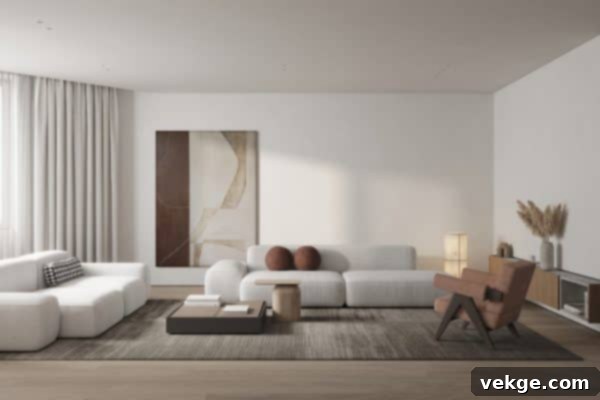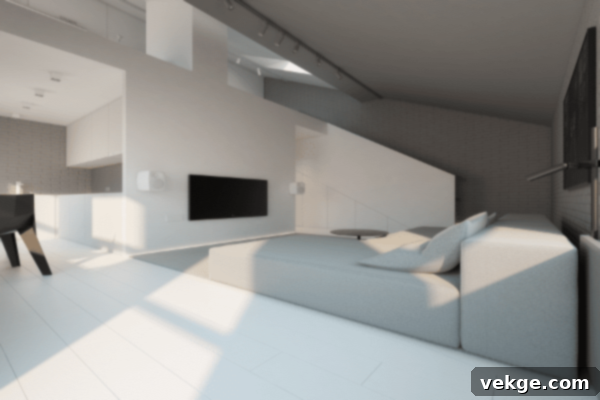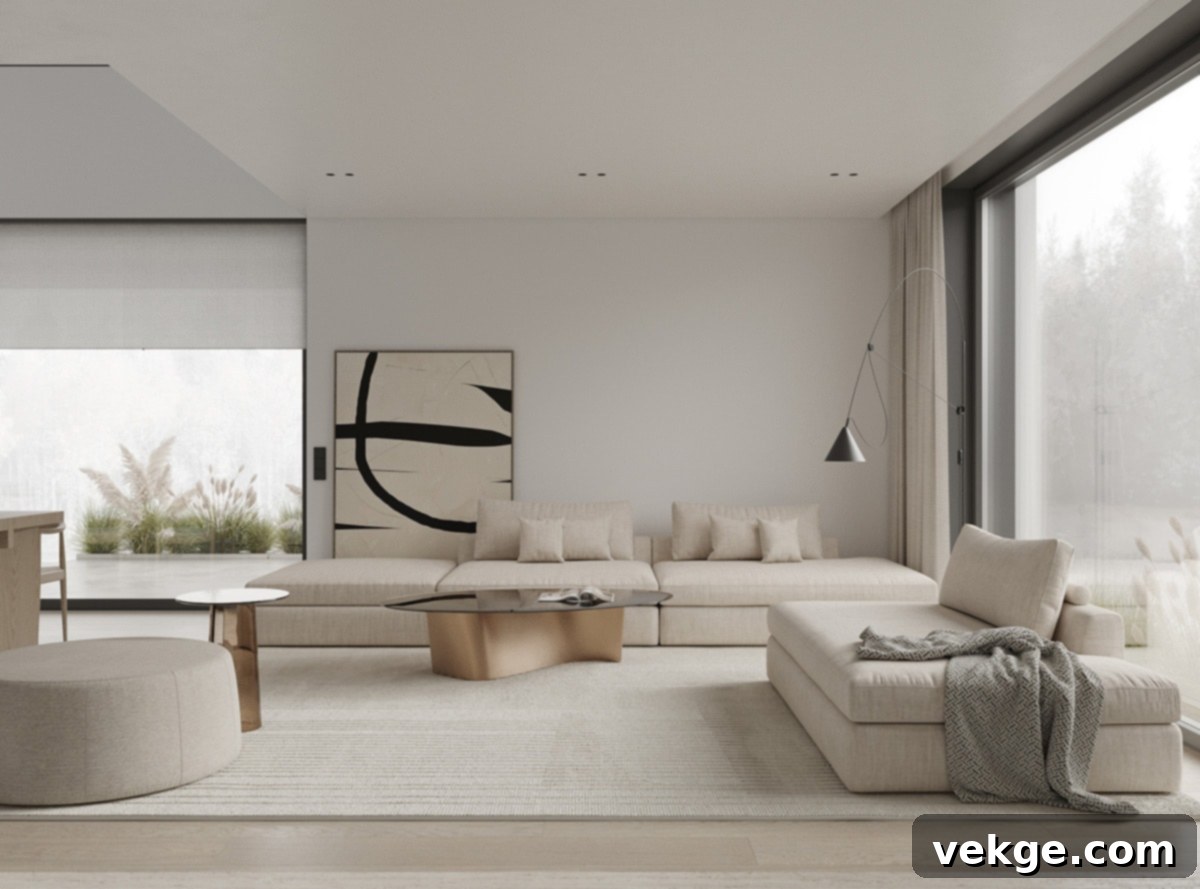Minimalist Decor: Unveiling the Pros and Cons for a Serene and Stylish Home
Minimalism, at its core, is a philosophy that champions the idea of “less is more,” emphasizing quality over sheer quantity. It’s a deliberate choice to strip down objects and environments to their most essential, functional forms. In the realm of interior design, minimalist decor translates into living spaces characterized by clean lines, uncluttered surfaces, and an overarching sense of calm and simplicity. This design approach is not merely about aesthetic preference; it’s a lifestyle choice that seeks to create harmony and efficiency within the home.
The contemporary design landscape has seen a flourishing of diverse minimalist decor ideas and trends, each bringing its unique flavor while remaining true to the foundational principles of minimalism. Popular styles include the tranquil elegance of Japanese minimalism, the functional warmth of Scandinavian minimalism, the inviting textures of Warm minimalism, the nature-infused elements of Biophilic minimalism, and the artful use of empty spaces in Negative Space minimalism. While each trend boasts distinctive features that define its identity, they all converge on the core concept of creating a thoughtful, purposeful, and visually peaceful living environment.
Embracing minimalist decor can profoundly transform a home, offering a plethora of benefits that extend beyond aesthetics. However, like any design philosophy, it comes with its own set of considerations. This comprehensive guide will delve into the advantages of cultivating a relaxing, clutter-free, and light-filled space, while also exploring the potential challenges, such as the perceived lack of personalization or identity that some homeowners might encounter. Understanding both sides of the coin is crucial for anyone considering this impactful design journey.
Pros of Minimalist Decor: Cultivating a Harmonious Living Space

The minimalist approach to home decor offers numerous compelling reasons to consider adopting its principles. Here’s a detailed look at the advantages that make minimalist living an attractive option for many seeking a more intentional and serene home environment.
1. Cost-Effective and Economical
One of the most immediate and tangible benefits of embracing minimalist decor is its cost-effectiveness. Financial considerations significantly influence all design decisions, whether for a professional interior designer or a homeowner embarking on a DIY project. Since minimalism is fundamentally about simplicity and acquiring only items of absolute necessity and high utility, it inherently leads to substantial savings. This philosophy encourages investing in fewer, high-quality pieces rather than numerous inexpensive ones, reducing initial decor costs and minimizing the need for frequent replacements. Over time, this focus on durability and essentialism means less money spent on transient trends and unnecessary decorative items, proving that a beautiful, functional space doesn’t have to break the bank.
2. Effortless Maintenance and Cleaning
Many individuals lament the sheer effort required to maintain a tidy home, often citing the overwhelming number of possessions as the primary culprit. Minimalist decor elegantly resolves this common challenge. By reducing clutter and curating a select collection of items, there are simply fewer things to clean, dust, and organize. This not only saves time but also reduces the mental load associated with upkeep. Furthermore, minimalist furniture often features clean lines, smooth surfaces, and simple designs, which are inherently easier to wipe down and keep pristine. The absence of intricate carvings or excessive embellishments means less dust accumulation and more straightforward cleaning routines, contributing to a consistently neat and inviting atmosphere with minimal fuss.
3. Enhanced Sense of Spaciousness
A hallmark of minimalist design is the abundant use of negative space, broad walkways, and open layouts. This strategic arrangement creates an impressive illusion of spaciousness, making even smaller rooms feel significantly larger and more expansive. The deliberate lack of clutter allows the eye to travel unobstructed, enhancing the perception of depth and openness. Natural light also plays a crucial role in this effect. Well-lit rooms, a common feature in minimalist homes, appear airy and inviting, while dimly lit or overcrowded spaces can feel constricted and heavy. By maximizing natural light and minimizing visual barriers, minimalist decor effectively transforms cramped areas into luminous, breathable sanctuaries.
4. Optimized Efficiency and Functionality
Adhering to the ‘less is more’ tenet, minimalist decor places a strong emphasis on the functionality and purpose of every item. Furniture and other objects are chosen not just for their appearance but for their practical utility and how they contribute to the overall efficiency of the living space. This thoughtful curation maximizes the full capacity of each room, enhancing its usability and flow. To further boost efficiency, multifunctional furniture is frequently integrated into minimalist designs. Examples include storage ottomans that serve as seating and hidden storage, sofas with built-in bookshelves, or convertible sofas that transform into beds, all designed to offer multiple benefits without adding visual clutter.
5. Elevated Aesthetics and Visual Harmony
Minimalist decor is celebrated for its sophisticated and elegant aesthetic. Its visual appeal stems from a deliberate focus on high-quality materials, meticulous curation, and a refined, often limited color palette. This approach results in spaces that are not only visually pleasing but also exude a timeless sophistication. The absence of distraction allows the beauty of individual pieces, textures, and architectural details to truly shine. Each element is thoughtfully selected to contribute to an overarching sense of harmony and balance, creating an environment that feels both luxurious and understated, making a powerful statement through its simplicity.
6. Eco-Friendly and Sustainable Living
A profound advantage of adopting minimalist decor is its inherent sustainability and environmental friendliness. This design philosophy naturally encourages reduced consumption and a preference for durable, high-quality materials that are built to last for years. By investing in fewer, more resilient items, homeowners contribute to significantly lower waste production, reducing their ecological footprint. The emphasis on longevity over disposability aligns perfectly with sustainable living practices, promoting conscious consumerism and a more responsible approach to home furnishing and decoration.
7. Reduced Stress and Enhanced Well-being
The psychological benefits of a minimalist home are substantial. A clutter-free, clean, light-filled, and spacious environment directly contributes to reduced stress levels and a heightened sense of calm. An organized and visually peaceful setting helps to quiet the mind, fostering a tranquil atmosphere conducive to relaxation and focus. This intentional design choice has a profoundly positive impact on mental and emotional well-being, promoting a sense of serenity and control amidst the demands of daily life. A minimalist home becomes a sanctuary, a place where one can truly unwind and recharge.
Cons of Minimalist Decor: Navigating the Potential Challenges

While the advantages of minimalist decor are compelling, it’s equally important to consider the potential drawbacks. Understanding these challenges can help homeowners make informed decisions and find creative solutions to mitigate any negative aspects.
1. Difficulty in Concealing Imperfections
In a minimalist setting, the concept of “less is more” means that every surface and detail is brought into sharp focus. This can pose a significant challenge when it comes to hiding minor imperfections within the home. Cracks in tiles, chipped paint, uneven plaster, damp spots on walls, or even a small stain on a pristine white couch become immediately noticeable and can disrupt the overall aesthetic. Unlike traditional decor, where one might strategically place carpets, decorative pots, throws, or paintings to obscure such flaws, minimalist design offers fewer opportunities for these clever cover-ups. Introducing additional items to an otherwise carefully curated and organized room risks compromising the visual appeal and the very essence of the minimalist aesthetic, making professional repairs often the only viable solution.
2. Risk of a Bland or Uninviting Look
Some homeowners may find that a strictly minimalist interior can appear cold, stark, or even bland. The deliberate reduction of color, patterns, and personal decorative items can sometimes convey an impression of a formal, unlived-in space, rather than a warm and cozy home. This perception of ‘coldness’ can deter those who crave a more inviting and vibrant atmosphere. However, this challenge can be mitigated. Introducing natural elements such as wooden accents, woven textures, or strategically placed plants can infuse warmth and organic beauty into a minimalist space. The rich, earthy tones and varied textures of wood, for instance, can make a room feel inherently more comfortable and welcoming without violating the core principles of minimalist design.
3. Perceived Lack of Personal Character and Expression
A common critique of minimalist decor is that it leaves limited room for personal touches and the expression of individual character. The emphasis on consistency, uniformity in accessories, a restricted color palette, and streamlined furniture can make it challenging to reflect the homeowner’s unique personality, interests, or life story. With fewer decorative items and a focus on clean simplicity, it can be difficult for a minimalist space to convey a sense of individuality or to create that distinct, cozy, and inviting atmosphere often achieved through personal mementos and diverse art. This can be particularly frustrating for those who cherish displaying collections or sentimental items, requiring creative solutions to integrate personality subtly.
4. Potential for Limited Storage Solutions
The minimalist philosophy encourages ruthless decluttering and retaining only essential items. While this promotes an organized environment, it can inadvertently lead to a shortage of storage space or, at best, a very limited amount. Even with the clever integration of multifunctional furniture, such as beds with built-in drawers or coffee tables with hidden compartments, the overall capacity for storing items that are not meant for display can be restrictive. This can become a significant problem for individuals or families with numerous practical necessities, hobbies, or sentimental items they wish to keep but not necessarily exhibit, challenging the practicalities of everyday living.
5. The Ongoing Challenge of Consistent Commitment
Adopting and maintaining a minimalist lifestyle is an ongoing commitment, not a one-time project. Over time, the natural human inclination to acquire new things can test one’s resolve. The temptation to buy new decor, gadgets, or personal items can be incredibly strong, making it hard to resist the gradual accumulation of objects. This eventual influx can quickly lead to clutter, undermining the minimalist aesthetic, and exacerbating any existing storage problems. Successfully maintaining a minimalist home requires continuous vigilance, regular decluttering rituals, and a mindful approach to consumption, making it a sustained effort rather than a passive state.
Conclusion: Finding Your Balance in Minimalist Decor
Upon examining both the advantages and disadvantages, it becomes clear that the benefits of minimalist decor often outweigh its potential drawbacks. While minimalist design excels at creating spaces that are undeniably spacious, clean, and aesthetically refined, there can be a perceived sense of coldness or disconnect due to the deliberate reduction of personal touches. Ultimately, the decision to embrace minimalist decor is a deeply personal one, hinging on what truly resonates with your lifestyle and aspirations for your home.
It’s crucial to remember that while aesthetics and trending styles matter, they should never overshadow your personal wishes, comfort, and the unique story you want your home to tell. Minimalism is not about rigid rules but about intentionality and clarity. You have the flexibility to interpret and adapt the latest minimalist trends, integrating your favorite pieces, cherished memories, and unique expressions of personality. The beauty of minimalist decor lies in its adaptability; it can be revolutionized to include elements that make your space uniquely yours, all while adhering to the core principles of simplicity, functionality, and calm. It’s about creating a home that supports your well-being, reflects your values, and brings you peace and joy, in whatever form that takes.
